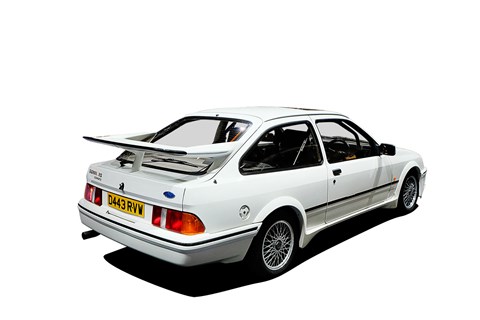► The blue-collar supercars
► Ford and Vauxhall via Lotus
► Ben Barry on historic hotshots
Vinyl interior, wood-rimmed wheel, standard-looking body. Little to suggest the Lotus Cortina was Britain’s first super-saloon… except the flash of Sherwood Green. That flash was painted by Lotus, communicating with a few grammes of poorly applied paint what bodykits and 20s do today: don’t mess. Very Lotus.
When Lotus added a twin-cam head to Ford’s new four and went racing, Ford saw the halo potential for its humble saloon; the Lotus Cortina was born.
Ford supplied two-door bodies, Lotus magic’d the rest: the 105bhp lump, close-ratio Elan gearbox, Girling brakes, alloy panels, even the leaf springs were ditched for coils.
You snuggle into deeply comfortable seats, the steering rim feeling incredibly delicate as you crank it at low speeds. But the weight soon eases and you point it into bends with precision, snicking the thin gearlever through ratios that keep this energetic engine screaming. There’s instant response to every throttle twitch, and the thick texture ripping from the exhaust positively encourages redline hunting. The Lotus Cortina feels hungry and alert, and soon you’re entirely confident chucking this old-timer around like a go-kart.
Shame that, over time, Lotus’s specialities became Achilles’ heels: the short ratios more suited to track than road, expensive alloy panels, trouble with rear suspension mounting points. From 1965, these parts were special-order only, not standard equipment. Likewise, the more numerous Mk2s were less specialist machines, built entirely at Dagenham. Really, you want a Mk1 with all the Lotus kit.
‘The Carlton more loutish than Lotus’
No such caveats for the Lotus Carlton: all follow the same recipe. Stuart Harris, Vauxhall product manager and chief liaison with Lotus, remembers the context. ‘[Lotus boss] Mike Kimberley and [GM boss] Bob Eaton wanted to show the Lotus/GM tie-up was working,’ remembers Harris. ‘GM had car-nut bosses before, but they’d reined it in because they had a business to run. Eaton couldn’t.’
It started with Carlton GSis transported from Rüsselsheim to Hethel, where Lotus spent 130 hours stripping each one down. ‘After that they’d be moved around a U-shaped shed on a dolley,’ says Harris. ‘There’d be a man with a blowtorch cutting out the transmission tunnel and welding in another, the rear arches being cut out and welded back in. No factory tours!’
The result was a comprehensively re-engineered machine: 3.6-litre twin-turbocharged six, a gearbox shared with the Corvette ZR1, AP brakes, revised suspension, brutish looks. The Lotus Carlton made 377bhp and 419lb ft and could hit 176mph. Contemporary BMW M5? Just 340bhp, 295lb ft and an electronically neutered 155mph top speed.
It takes time for the Carlton’s turbos to spool, but once you’re into the meat between 2500 and 5000rpm it’s still a quick car. And that turbo kick is seriously addictive. Accelerate hard from a standing start and you anticipate the sudden lunge, that moment when the tyres stop gripping and start slipping, smearing down the road as the LSD locks. Slot second – lightish shift, heavy clutch – and repeat until, finally, in third, the tyres regain composure. The Carlton’s perfectly benign through tighter turns, but the faster stuff really gets your attention: heavy steering and soft suspension makes this a lot of metal to hussle.
The Cortina is more representative of Colin Chapman’s delicate touch, the Carlton more loutish than Lotus, but both elevate mass-market mundanity to unexpected greatness. Someone, please, send Lotus a Vauxhall VXR8.
The specs
Lotus Cortina
Produced: 1963-1970
Price at launch: £910
Value now: £40k-£80k
Engine: 1558cc inline four, 110bhp, 107lb ft
Performance: 13.6sec 0-60mph, 108mph
Lotus Carlton
Produced: 1989-1994
Price at launch: £48,000
Value now: £10k-£35k
Engine: 3615cc straight-six, 377bhp, 419lb ft
Performance: 5.1sec 0-60, 176mph
Other Fords and Vauxhalls we cherish
Escort RS1800 Mk2 1974-1981
Humdrum Mexicos were shipped from Germany to South Ockendon, Essex, where Cosworth-developed BDA 16vs were installed. Waldegard and Vatanen won WRC in ’79 and ’81.

Sierra RS Cosworth 1986-1992
Jellymould styling was forgotten when Bob Lutz stuck on a whale tail and asked Cosworth to slot Pinto-based YB twin-cam under the vented bonnet.
GT40 1964-1969
Multiple ’60s Le Mans winner had a heart of Detroit V8 muscle, but it was developed in collaboration with Lola Cars’ Eric Broadley, and closely mirrored Lola’s earlier Mk6.Vauxhall

HP Firenza ‘Droopsnoot’ 1975
‘Droopsnoot’ front improved aero, Blydenstein-tweaked 2.3-litre slant four made 131bhp, and both helped Gerry Marshall to saloon-car trophies. 204 made.
Chevette HS & HSR 1976-1981
HS homologated for Group 4 rallying, had success with Jimmy McRae, Pentti Arikkala and Tony Pond. Spot ultimate HSR by boxy arches.
Mk2 Astra GTE 1987-1990
Chassis never up to the job, but 20XE 2.0-litre 16v engine was the era’s best, with 156bhp to contemporary Mk2 Golf GTI 16v’s 139bhp.